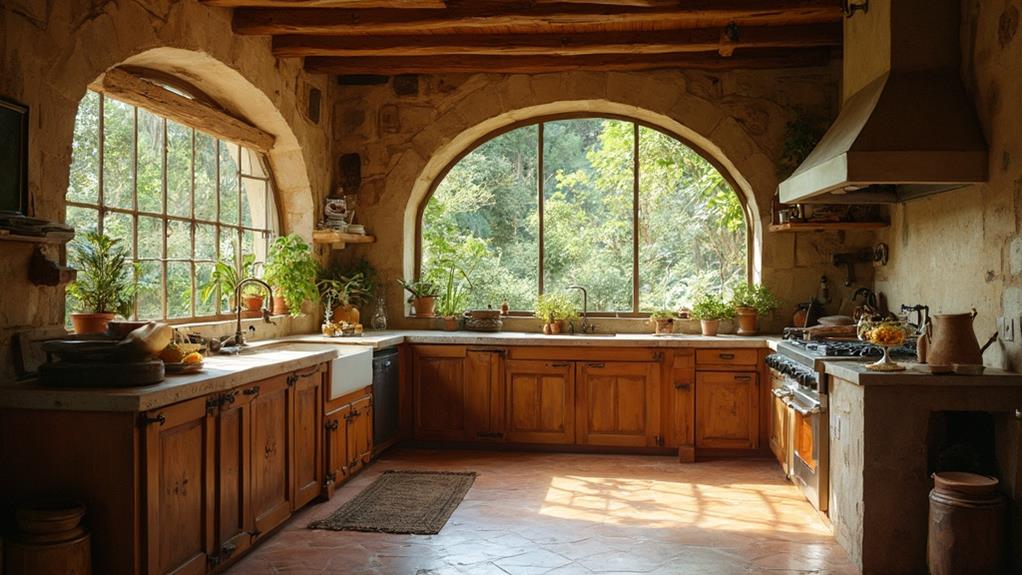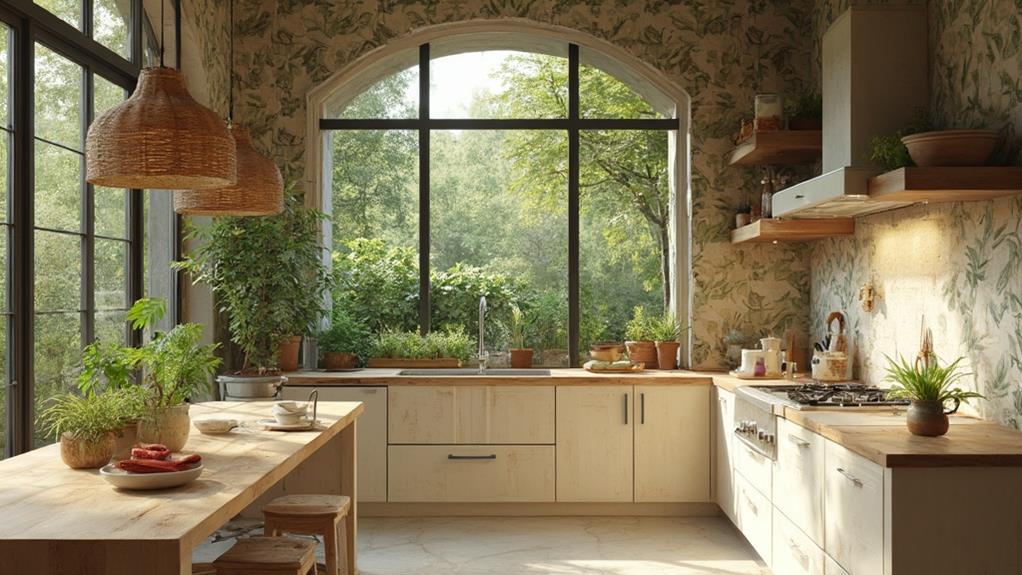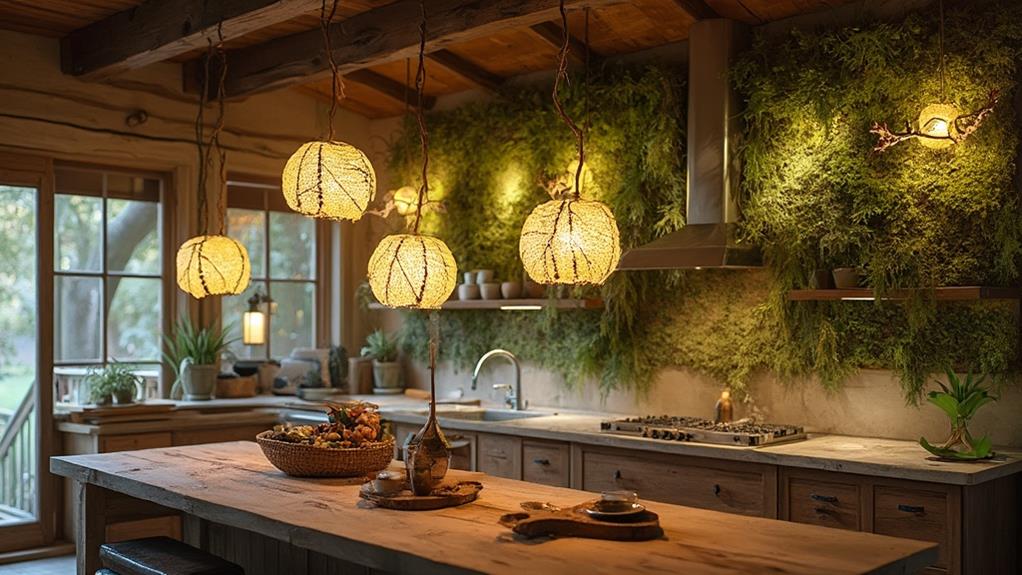To create a nature-inspired kitchen, start with an earthy color palette of warm neutrals and natural accents. Choose countertops made from materials like granite, wood, or bamboo for an organic feel. Incorporate organic textures and patterns through wood grain cabinets, stone-like tiles, or botanical prints. Embrace biophilic design by adding indoor plants, maximizing natural light, and using nature-inspired colors. Opt for lighting solutions that mimic daylight or natural forms, such as leaf-shaped fixtures or smart systems that sync with circadian rhythms. By combining these elements, you'll transform your kitchen into a serene, nature-inspired space. Discover how each aspect contributes to a harmonious and refreshing design.
Earthy Color Palette Choices

For an earthy color palette in your nature-inspired kitchen, start with warm, neutral tones. Choose colors like sandy beige, soft brown, and muted olive green as your base. These hues will create a soothing backdrop that mimics the natural world.
Complement these with accents of terra cotta, deep forest green, or rich ochre to add depth and interest.
Don't shy away from incorporating wood tones into your color scheme. Whether it's through cabinetry, flooring, or decorative elements, wood adds warmth and texture that's essential to a nature-inspired design. Consider using different wood finishes to create visual variety while maintaining a cohesive look.
For a pop of color, look to nature's vibrant elements. Incorporate shades of sky blue, sunflower yellow, or leaf green through accessories, backsplashes, or small appliances. These brighter hues will enliven your space without overwhelming the earthy foundation.
Remember to balance your chosen colors. Use the 60-30-10 rule: 60% dominant color, 30% secondary color, and 10% accent color. This approach will ensure a harmonious and visually pleasing kitchen design that truly captures the essence of nature.
Natural Materials for Countertops
When selecting countertops for your nature-inspired kitchen, you'll want to consider materials that echo the beauty of the outdoors. Natural stone options like granite, marble, and quartzite offer unique patterns and colors that mimic the earth's geological formations.
Granite provides durability and heat resistance, while marble adds a touch of elegance with its distinctive veining. Quartzite combines the best of both worlds, offering strength and a wide range of colors.
For a warmer, organic feel, consider wood countertops. Butcher block or reclaimed wood can bring a rustic charm to your kitchen while connecting you to nature. If you're looking for an eco-friendly option, bamboo countertops are sustainable and offer a unique, light appearance.
Concrete countertops can be customized to incorporate natural elements like pebbles or shells, creating a one-of-a-kind surface that reflects your personal style. For a more budget-friendly option that still maintains a natural look, consider quartz countertops. These engineered stones can replicate the appearance of natural materials while offering superior durability and low maintenance. Whichever material you choose, ensure it complements your overall nature-inspired design theme.
Organic Textures and Patterns

Incorporating organic textures and patterns into your kitchen design can bring the essence of nature indoors. You'll find numerous ways to achieve this, from subtle touches to bold statements.
Consider using wood grain patterns on cabinet doors or flooring to mimic the natural lines found in trees. You can also opt for textured tiles that resemble stone or bark for backsplashes or accent walls.
Don't overlook the power of fabrics and wallpapers featuring botanical prints or nature-inspired motifs. These can add a soft, organic feel to your kitchen space.
For a more dramatic effect, install a feature wall with a large-scale nature photograph or mural.
When selecting hardware and fixtures, look for pieces with organic shapes or finishes that mimic natural elements. Hammered copper sinks, brushed bronze faucets, or drawer pulls shaped like twigs or leaves can add subtle nods to nature throughout your kitchen.
Remember to balance these organic elements with clean lines and smooth surfaces to prevent the space from feeling overwhelming. By thoughtfully incorporating organic textures and patterns, you'll create a kitchen that feels connected to the natural world while remaining functional and stylish.
Biophilic Design Elements
Biophilic design elements bring the outdoors in, creating a stronger connection between your kitchen and nature. You can incorporate these elements through various means, such as adding indoor plants, using natural materials, and maximizing natural light.
Start by introducing potted herbs or small plants on your countertops or windowsills. They'll not only add a touch of greenery but also provide fresh ingredients for your cooking. Consider installing a vertical garden or living wall for a bold statement piece that purifies the air and adds visual interest.
Utilize natural materials like wood, stone, and bamboo in your cabinetry, countertops, and flooring. These materials add warmth and texture while reinforcing the connection to nature. Opt for large windows or skylights to flood your kitchen with natural light, reducing the need for artificial lighting and creating a more open, airy feel.
Incorporate nature-inspired colors like earthy browns, forest greens, and sky blues into your color palette. These hues can be used in paint, backsplashes, or accessories to evoke a sense of the outdoors. Finally, consider adding water features like a small fountain or aquarium to bring in the soothing sounds and movement of nature.
Nature-Inspired Lighting Solutions

Designed to mimic natural light patterns, nature-inspired lighting solutions can transform your kitchen into a dynamic, organic space. You'll find a range of options that capture the essence of sunlight, moonlight, and even the soft glow of fireflies.
Consider installing skylights or light tubes to bring in natural daylight, reducing your reliance on artificial lighting during the day. For a more budget-friendly option, try daylight-mimicking LED bulbs that change color temperature throughout the day, simulating the sun's natural cycle.
Pendant lights inspired by natural forms, such as leaf-shaped fixtures or globe lights resembling full moons, can add visual interest while providing focused task lighting. Install under-cabinet lighting that mimics the soft glow of bioluminescent organisms, creating a subtle ambiance for nighttime snacking.
For a truly immersive experience, integrate smart lighting systems that sync with natural circadian rhythms. These systems adjust brightness and color temperature automatically, promoting better sleep patterns and overall well-being.
Don't forget about accent lighting to highlight natural elements in your kitchen, such as potted herbs or a living wall. Use warm, dimmable lights to create a cozy atmosphere reminiscent of a sunset-lit forest clearing.
Conclusion
You've planted the seeds for a kitchen that's a breath of fresh air. As you harvest the fruits of your nature-inspired design, you'll find yourself in a space that's as refreshing as a forest breeze. Let your kitchen become a sanctuary where earthy hues, organic textures, and biophilic elements flourish. With every meal you prepare, you'll be nurturing your connection to the natural world, creating a feast for all the senses.

